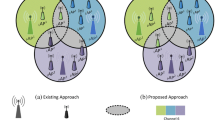Abstract
In the near future, the Internet is likely to become an All-IP network that provides various multimedia services over wireless networks. Although the earliest VoIP applications did not consider the end-node mobility, researchers have attempted to support mobility in current VoIP protocols, such as Session Initial Protocol (SIP)-based mobility. The SIP-based mobility is considered because it can readily support mobility. However, calling disruptions may occur in traditional SIP mid-call terminal mobility because handoff procedure may be required, depending on the implementation and the real network deployment considerations. In any case, issues in the combined SIP/RSVP for guaranteeing QoS of VoIP service under mobile environment are also considered to be crucial. Therefore, this study describes the solutions by devising novel hierarchy network architecture. Also, the mechanisms including help with neighboring users in adjacent cells and the third party call control to overcome those issues are included. The simulation results indicate that the proposed technique is practical and better executive than conventional schemes.
Similar content being viewed by others
References
Schulzrinne H., Wedlund E. (2001)“Application-Layer Mobility Using SIP”. ACM Mobile Computing and Communication Review. 1(2): 47–57
A. Misra, S. Das, and P. Agrawal, “Application-Centric Analysis of IP-based Mobility Management Techniques”, Journal of Wireless Communications and Mobile Computing, Vol. 1, No. 3, 2001. Wiley Interscience, New York.
K.D. Wong, A. Dutta, J. Burns, R. Jain, K. Young, and H. Schulzrinne, “A Multilayered Mobility Management Scheme for Auto-Configured Wireless IP Networks”, IEEE Wireless Communications Magazine, 2003.
K.D. Wong, A. Dutta, K. Young, and H. Schulzrinne. On handling. in C. Politis, K. Chew, and R. Tafazolli (eds.), “Multilayer Mobility Management for All-IP Networks: Pure SIP vs. Hybrid SIP/Mobile IP”, IEEE VTC, 2003.
G. Camarillo, W. Marshall, and J. Rosenberg, “Integration of Resource Management and SIP”, RFC3312, IETF, 2002.
Yang X., Agarwal A. “Multicst Mobility in SIP Layer”, in Proceeding of Vehicular Technology Conference, 2004. VTC 2004-Spring. 2004 IEEE 59th, Vol. 5, pp. 2667–2671, 17–19 May 2004.
J.-W. Jung, R. Mudumbai, D. Montgomery, and H.-K. Kahng, “Performance Evaluation of Two Layered Mobility Management using Mobile IP and Session Initiation Protocol”, IEEE GLOBECOM, 2003.
H. Schulzrinne and J. Rosenberg, “The Session Initiation Protocol: Internet-Centric Signaling”, IEEE Communication Magazine, 2000.
T.T. Kwon, M. Gerla and S. Das, “Mobility Management for VoIP Service: Mobile IP vs. SIP”, IEEE Wireless Communications, 2002.
H. Khlifi, A. Agarwal and J.-C. Gregoire, “A Framework to Use SIP in Ad-hoc Networks”, IEEE CCECE, 2003.
Sinnreich H., Johnston A.B. (2001) Internet Communications Using SIP. New York, Wiley
Author information
Authors and Affiliations
Corresponding author
Rights and permissions
About this article
Cite this article
Wu, Ty., Jhang, Rw. & Chao, Hc. Efficient Architecture and Handoff Strategy used for VoIP Sessions in SIP Based Wireless Networks. Wireless Pers Commun 43, 201–214 (2007). https://doi.org/10.1007/s11277-006-9218-3
Received:
Accepted:
Published:
Issue Date:
DOI: https://doi.org/10.1007/s11277-006-9218-3




